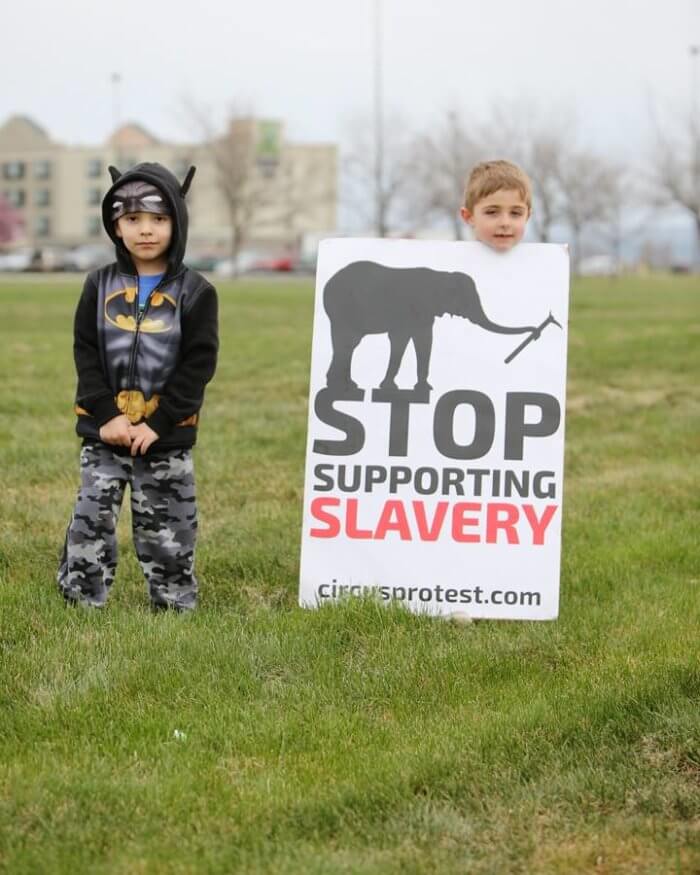Every week, CompassionWorks International (CWI) observes, investigates, and reports on the unforgivable levels of abuse suffered by elephants currently confined to the circus. At each and every circus performance, the elephants can be witnessed in a state of agitation or despair. They rock back and forth, make repetitive head movements, or engage in other stereotypical behavior, which elephant experts have noted are clear indicators that captivity is mentally and emotionally harmful to elephants.
While massive progress is being made to put an end to circus cruelty through raising public awareness and passing new laws, elephants deserve, and have a right to, immediate relief from the endless days spent chained, confined, beaten, and threatened with injurious weapons. For this reason, CWI is pleased to support the Nonhuman Rights Project’s lawsuit to recognize the fundamental right to bodily liberty of Beulah, Karen, and Minnie, three elephants whom we have observed being forced to give rides as a part of the Commerford Zoo.

What is evident in monitoring captive elephants, and what science bears out, is that they are self-aware, emotionally complex beings capable of compassion, grief, suffering, and joy. To fail to acknowledge that they are sentient beings with their own experience of existence, and to deny them their right to that experience by jailing or enslaving them, is reflective of an outmoded ideology that lacks both scientific credibility and compassion.
The circus is an excellent example of the type of antiquated thinking that results in continued animal suffering. In 1805, Hachaliah Bailey purchased an elephant he named Old Bet, who is thought to be the first elephant to perform in a circus in the United States. Realizing he could profit from those wanting to see an elephant, Bailey began touring with Old Bet and then, after she was shot to death by a farmer, with replacement elephant Little Bet. From there, the interest in displaying elephants grew and evolved into the development of performing elephant shows by Barnum and Bailey Circus in the 1890s.
During this same period, fascination with the “other” grew immensely throughout the United States and Europe. Not only did that era birth the modern American circus, but also “human zoos,” which featured the exhibition of peoples of diverse ethnological backgrounds or individuals who exhibited unique traits, like the Siamese Twins Chang and Eng Bunker, who were capitalized on by none other than P.T. Barnum. At both the 1878 and 1889 Parisian World’s Fair, a “Negro Village” was developed that displayed 400 indigenous peoples. The Village was the central attraction of the 1889 Fair, which was visited by 28 million people.
While our knowledge of and compassion for humans has grown to the point where we no longer cage human individuals for entertainment at public fairs, our compassion toward elephants and other nonhuman animals has sadly lagged behind. Humans continue to confine, enslave, inflict suffering on, and profit off of those who have no language with which to protest injustice that humans choose to acknowledge. Circuses and other industries that use and abuse elephants maintain a nineteenth century modus operandi, living in willful ignorance of their actions for the purpose of making a quick buck.
At CompassionWorks International, we work toward enlightening the public to the reality of what captivity means for nonhuman animals. By re-contextualizing their suffering into a relatable framework, we seek to advance understanding of nonhuman animals to fall in line with current knowledge. Through our public anti-animal circus demonstrations, investigations of elephant cruelty, community awareness campaigns, videos, and social media outreach, we focus on revealing the ways in which elephants respond and react to the world “just like humans do.” Because when a human individual can recognize her/himself in another, when pain or joy or love or suffering is felt and understood, change is inevitable. The words of Baba Dioum ring true: “In the end we will conserve only what we love; we will love only what we understand; and we will understand only what we are taught.” We have witnessed that philosophy prove successful time and again in our advocacy work, which has led to the ending of Ringling Bros Circus as well as additional smaller circuses, an overall reduction in the number of individuals attending the circus, an increase in the number of individuals advocating against the circus, and the passing of over 135 local laws across the United States against circus cruelty.
Reflected in our logo and throughout our work against animal circuses, zoos and other forms of captivity, CWI took the plight of elephants as one of our founding campaigns. We believe that the animal advocacy sector must reflect on the pivotal question, “If we can’t save the beloved elephant, what nonhuman animal can we save?” as we consider our direction and strategies toward building a non-speciesist world. We are gratified that the NhRP recognizes the same and is directing its attention toward the terrible plight of Beulah, Karen, and Minnie, who must immediately be removed from a life of chains and remanded into the custody of the Performing Animal Welfare Society where they can live out their days in a sanctuary environment that is capable of understanding and catering to their unique needs as individuals.
CWI congratulates the NhRP for lifting contemporary thought on nonhuman animals out of the nineteenth century and demanding that the treatment of nonhuman animals falls in line with our knowledge of them as autonomous, sentient beings deserving of the same rights and respect afforded to any human animal.